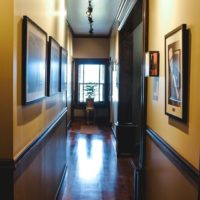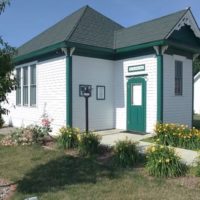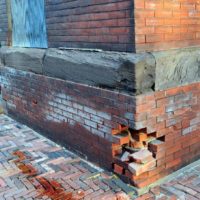Preservation at its Best 2017, Public Structure: Burlington Northern Depot (Osceola)
The project was executed in two phases. Construction for the phase one site improvement portion of the work started in April 2015. Construction for the phase two, building restoration/rehabilitation portion of the work started in October 2015 and was completed in May of 2016. A ribbon-cutting ceremony was held in August 2016, attended by the project’s most persistent and enthusiastic advocate, former Osceola Mayor, Fred Deihl. Mayor Deihl passed away a few months later.
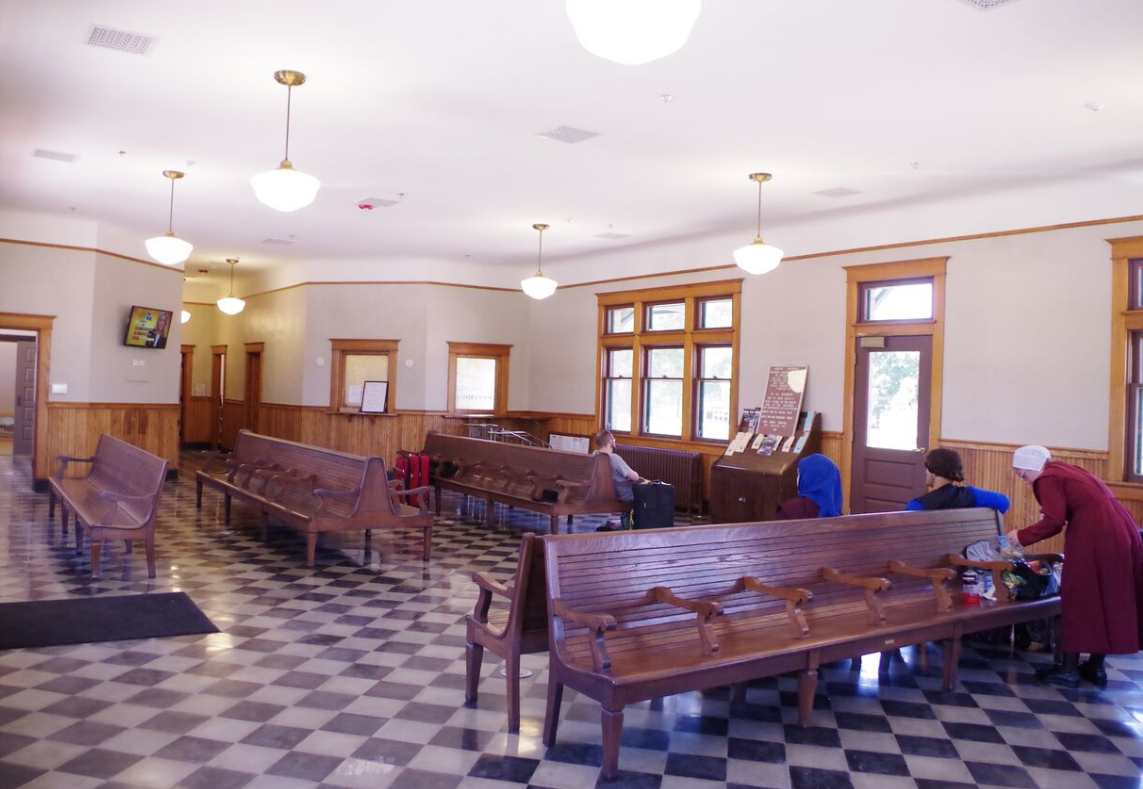
Osceola Burlington Northern Depot, interior waiting room
Osceola’s Chicago, Burlington, & Quincy Depot was constructed in 1907. Excepting a small basement mechanical room, the Depot is a one-story building that is 3,800 square feet. The building has the rare distinction of being a passenger rail depot that has remained in continuous operation since it was built. It is, still, one of Iowa’s five Amtrak boarding points and records the highest number of passengers of those active stations.
The City of Osceola assumed ownership of the property in 2007 and immediately began planning for restoration/rehabilitation work. The building was listed on the National Register of Historic Places in 2009. Historical significance includes ties to the development of the railroad industry, the building-proper as an exemplar of a standard combination depot configuration with high degree of integrity, and many important connections to the community and adjacent downtown courthouse square district.
While the building had been maintained by the railroad through the years, it had never seen any significant upgrades. As many as 14 layers of paint were identified on some plaster surfaces. The main lobby had been divided into two spaces by a drywall partition. Otherwise, the building’s configuration was little modified. Mechanical, electrical, and plumbing systems were largely original.
Phase One site work included installation of new site utilities, installation of new parking and drives, installation of new site lighting, discreet entry ramps, and re-installation of historic brick pavers in the immediate vicinity of the building. What had previously been a gravel parking lot with uneven sidewalk areas by the building was replaced with a fully paved and landscaped area providing an accessible route from parking to the building entries.
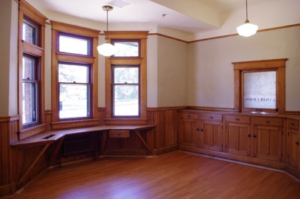
Osceola Burlington Northern Depot office restoration
Phase Two building restoration and rehabilitation included restoration of existing historic lobby, ticket office and office; including refurbishment of concrete tile floors with cove base, repair and refurbishment of existing painted plaster wall and ceiling surfaces, and refinishing of existing historic wood wainscot and door/window trim. The work also included modifications to existing building configuration at former non-public baggage spaces to accommodate new toilet rooms and other support spaces.
Throughout the entire building the project included installation of new HVAC systems, new plumbing systems, new electrical and lighting systems, new alarm and detection systems, and new automatic fire suppression systems. The primary equipment for these systems was located in the small partial basement space with distribution strategically routed to reach and serve the occupied areas with minimal visual impact. New lighting, HVAC grilles, sprinkler heads, and other visible systems elements were selected to be sympathetic with the historic character of the historic interiors.
Exterior building work included painting and selective tuckpointing. The building’s exterior had been substantially rehabilitated in a separate project accomplished within the last 10 years.
The chief challenge in the project were keeping the restoration zone of the building intact while accommodating the new functions and systems. The configuration of the lobby, public hallway, former ticket office, and former women’s lounge were maintained and finishes restored. New systems were routed through the attic and the crawl space. New restrooms and other support spaces were configured to utilize the former non-public baggage areas where a “new versus old” architectural expression was deployed.
The Osceola Depot continues to serve central Iowa as a departure & arrival point for Amtrak service. For these passengers, the depot is the City’s “welcome mat.” The restored historic spaces and newer ADA-compliant support spaces form a positive impression, and encourage visitors to explore the adjacent Downtown while waiting to board the California Zephyr.
The City budgeted $1.43 million dollars total for phase I and II of the project. The majority of the funding came by way of a $911,000 Statewide Transportation Enhancement Program grant through the Iowa Department of Transportation. The project was also awarded an $88,000 CAT grant from the Vision Iowa Board. The Clarke County Development Corporation pledged $100,000 and Clarke County pledged $25,000 to the project. The local Friends of the Depot nonprofit group raised over $30,000 in local donations, which included $10,000 from Lakeside Casino. The balance of the project was funded by the City of Osceola.
Preservation Iowa’s two most visible programs are Iowa’s Most Endangered and Preservation at Its Best. These two programs work well together because being listed as Most Endangered often times leads to awareness, a preservation effort, and a high-quality, award winning project.
The full list of Preservation Iowa’s 2017 Preservation at its Best award winners include:
- Globe Tire
- Green & Main
- Roosevelt School (Clinton)
- Wonder Bread Building / Single Speed Brewing
- Osceola Burlington Northern Depot
- Newton Historic Preservation Commission
- Kauffmann House
- Reverend John Todd House
- Franklin Apartments
- Frankie House
- Bent River Brewery

